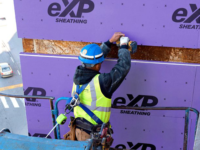The Time of His Life

For nearly 40 years, Bob Drury has served the wall and ceiling community proudly through his position as executive director with the Northwest Wall and Ceiling Bureau. What readers may or may not know is that he also has close ties to Walls & Ceilings-his father-in-law ran the magazine decades ago.
Now on the brink of retirement, Drury took time for an extensive interview with W&C to reflect on his time with the NWCB, its accomplishments, how the industry has changed and evolved and what his future plans are.
All of us at W&C congratulate Drury for a remarkable career that has been not only been productive but exceptional.
Bob, you were introduced to the industry by your father-in-law? Or tell us the genesis of how you became involved?
My wife Dorothy’s father Chuck Clay was executive director of the Lath and Plaster Bureau and owner of Walls & Ceilings magazine. After college, I worked part time for the magazine doing layout, while my full-time job was working as an engineer for the Boeing Co., designing the interiors of the airplanes and emergency features.
How would you define your first position?
I was asked by the Northwest Lath and Plaster Bureau to take the position of architectural consultant in 1972. So I left Boeing and started this job. About a year and half later, Charles Clay passed and I was appointed the executive director by the board of directors.
What are your responsibilities within this position?
How I view the responsibility is that, first of all, it is to be the visionary source for the industry in the Northwest. The other responsibility is to be the administrator and technical person for the daily operation for Northwest Wall and Ceiling Bureau.
It is important in this job to enjoy working with people. I learned right away that there are a lot of people with different agendas. A person in this position has to bring everyone together for the common goals of the industry.
When I first started the job, I spent much of my time in the field, often up on scaffolds, looking at how interior and exterior work was being performed. I made a point to communicate and relate well to those working the field as well as to management personnel and to understand their duties. I also worked with city officials and key people in the construction industry. I had to able to mingle and communicate with a lot of different types of people.
As far as lobbying goes, our main goals with city and state government were to influence building codes and to get uniformity from the building inspectors in the field. That was very challenging because there are so many different municipalities in the Northwest, and the city of Seattle has its own building code. The NWCB’s work with the building codes paid off. Eventually, I was on the advisory board for building code for the city of Seattle and active in construction-related organizations.

At that time, there was the plastering industry and drywall industry-they weren’t under one uniform organization. I saw that there were a lot of the same manufacturers and contractors doing both scopes of work in drywall and plastering, and one industry organization was needed to achieve the goals of these two trades.
At that time, in the late-70s, metal framing was really starting to take off and so were various drywall assemblies, such as shaftwalls and fire and sound rating (in commercial construction). Another major change that started to take place was prefab panels and EIFS in the mid-80s. I felt this exterior work was really challenging and interesting. I saw a big future for this in the Northwest for all involved in our industry (contractors, manufacturers, distributors, etc.)
The organization’s name changed to Northwest Wall and Ceiling Bureau in the early ’80s. That became a great opportunity to work with architects, owners and general contractors to promote all scopes of work of the wall and ceiling industry. The construction community embraced and welcomed new building materials, such as EIFS and exterior claddings. Today, that effort and dedication to the exterior work of stucco and EIFS is still key to NWCB.
During this time, NWCB was becoming more and more of a go-to place for people that wanted to find out how to design, specify and build various wall and ceiling work, and with that came the opportunity to sell architects and owners more work. Once I became involved on a project, I could point out and find other products and systems, such as metal framing and drywall assemblies, that could be used in place of masonry. One of the biggest opportunities our industry presents to the project is the aesthetics that the products can create for the architect and owner. We are in the finishing business-there are numerous choices that owners and architects have and we explore those all the time.
Metal studs and drywall assemblies, being relatively new in the architectural community, then also became a big part of our efforts for improving and expanding the industry in this region. Load bearing steel framing still has a tremendous opportunity in construction.
What is the biggest change you have seen in your years of service?
I would say the trend of general contractors is to do less self-performing of the work. The GCs are becoming more like managers and brokers, and that has been an advantage for contractors in our industry in that it offers more business to us.
I think another change has been the technology. Currently, the advancement of electronic communication from office to field has taken away the enormous amount of paper work done. It’s a huge difference.
There’s also been an impressive stream of new products to the market in the last five years. Having said that, there has been a big decline of interior plaster work being done and it is being replaced by new types of board products, systems and interior finishing, coatings, such as Venetian plasters and more specialty products.
The new ceiling systems are also impressive in the incredible variety of products now offered.
What threats should the wall and ceiling industry be vigilant of in the future?
I think the threats are intangible things that the industry for the most part has no control over. But as an industry and a company in business we need to be aware and plan ahead for things such as economic downturn and construction slowdowns. Run your business smart and plan for change.
Another threat is the over abundance of state and federal regulations that make it difficult to do business. The nature of our scope of work requires a top-notch workforce. We need to have good apprentice programs and be aware that the labor force is extremely important. We need to surround ourselves with quality people.
What do you feel have been your greatest accomplishments within the NWCB?
One of my biggest accomplishments has been elevating the NWCB to be recognized in our region as an authority and expert on all phases of the wall and ceiling business. This has been accomplished by being responsive to what our members and the construction industry needs. We want to be an authority not for selfish reasons but because it serves the industry as a whole.
We have a tremendous reputation within the building community as a single source to go to in the wall and ceiling industry. Almost all project construction documents in the Northwest reference the NWCB for performing wall and ceiling work. We have a library of technical documents our members rely on a daily basis for their jobs.
In addition to the technical documents, we produced the “Stucco Resource Guide.” People buy that book all across North America now. Another important document that the Bureau published is the “Impacts to Labor Productivity in Steel Framing and the Installation and Finishing of Gypsum Wallboard” guide.
Will the conventions continue?
The Northwest Wall and Ceiling Industries Convention and Trade Show will continue. I’m proud of how our conventions have evolved and become one of the most important industry events available. This is something the whole staff at NWCB should be very proud of.
Were there any goals that you feel have gone incomplete? Any regrets?
I regret we couldn’t broaden membership more in the various regions. We had requests to go to other parts of North America in the West. We could not do that with the funding we have and provide the same service that we offer our members.
After so many years serving the industry, are you truly ready to step back from it altogether or will you still be involved on some level? Please elaborate.
I have been fortunate enough to have spent so much of my life doing what I did. I look forward to going to work. I’ve enjoyed what I’ve done. I will miss the issues and the challenges of solving problems and meeting people. As far as the future, there will be a transition period with the new executive director and I will be available as needed to help on current needs or special projects.
When you leave, who will be charged to take on the task to lead the NWCB?
Mark Eisenmann. He is a graduate of construction management from Washington State University. He was a branch manager with a specialty construction company, has worked with the NWCB and knows the industry. I think Mark will do a wonderful job and he’s great with people.
How do you plan to spend retirement?
I don’t have any specific plans, but I’d like to keep my hand in the industry. I’ll probably play more tennis, go fly fishing and spend more time on Lopez Island here in Washington. I would like to spend more time with my grandkids.
Where do you want to see the Bureau go?
Where I’d like to see the NWCB go is to elevate the industry and the contractor base so they are recognized as a bigger part of the team on a project. In other words, bring more attention to the wall and ceiling work in the eyes of the construction community to improve wall and ceiling contractors’ business. I would also like to see the continuation and expansion of the recognition of the NWCB.
What closing comments would you like to share with our industry and NWCB members?
I’d like to express my gratitude to all the members throughout the many years for their support. For allowing me to be in the position that I was in, to be able to be creative and feel proud of what I was doing-all the while helping the industry. I have been really fortunate to have wonderful people working with me for all the years I’ve been here. They are very dedicated individuals. Every day we have challenges and find solutions.
Looking for a reprint of this article?
From high-res PDFs to custom plaques, order your copy today!






